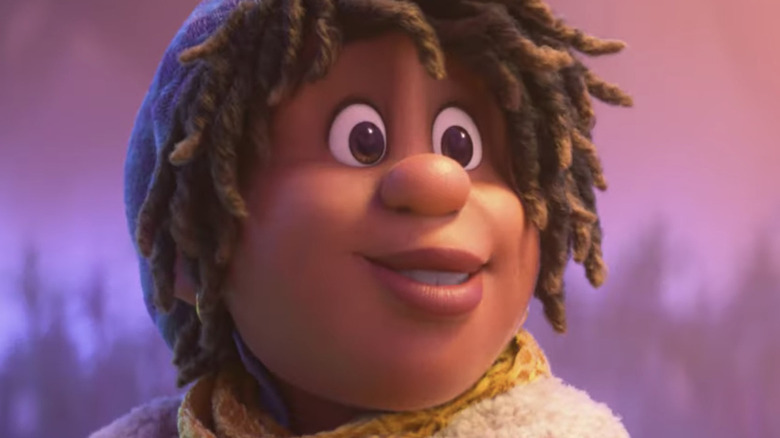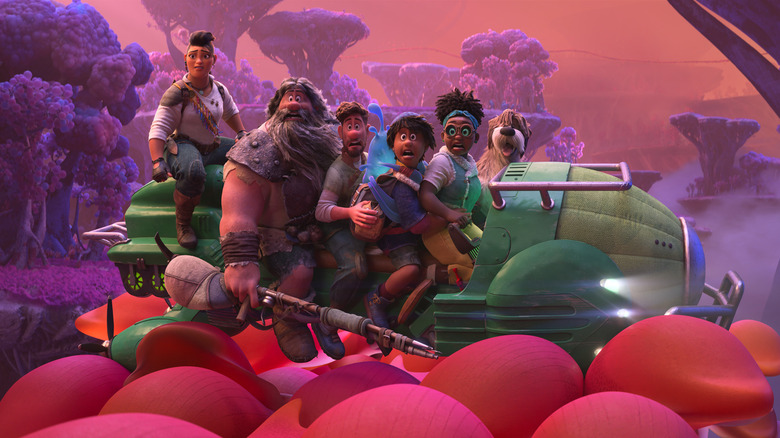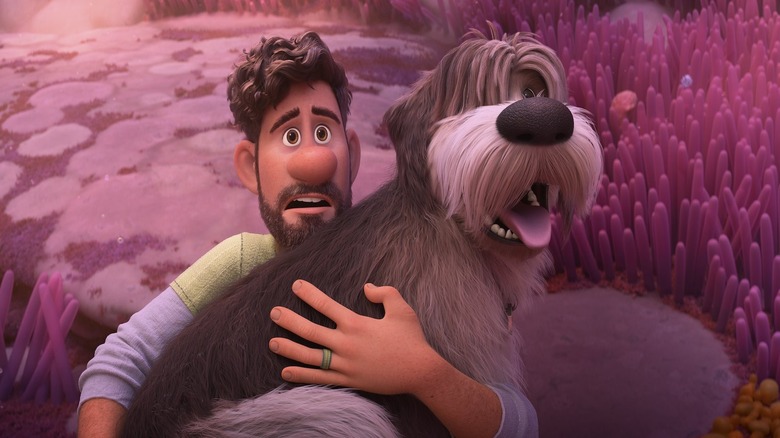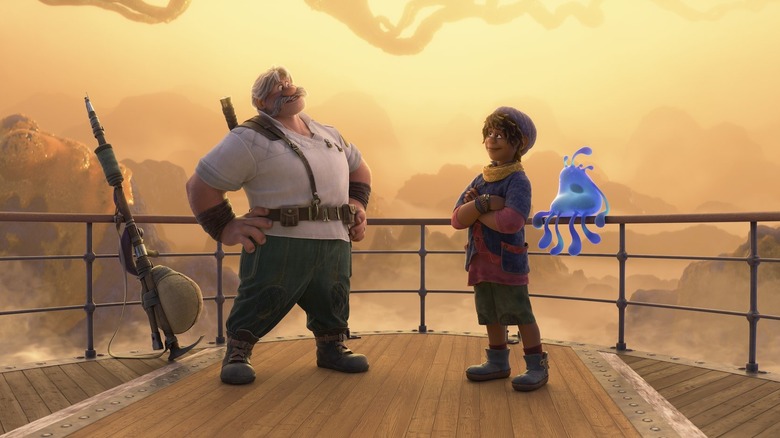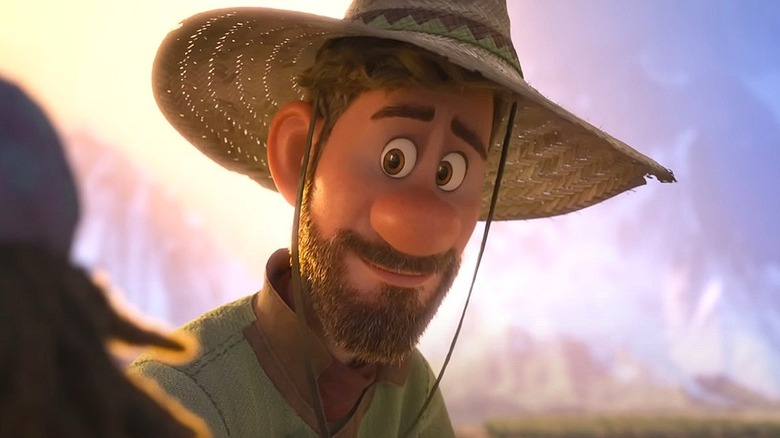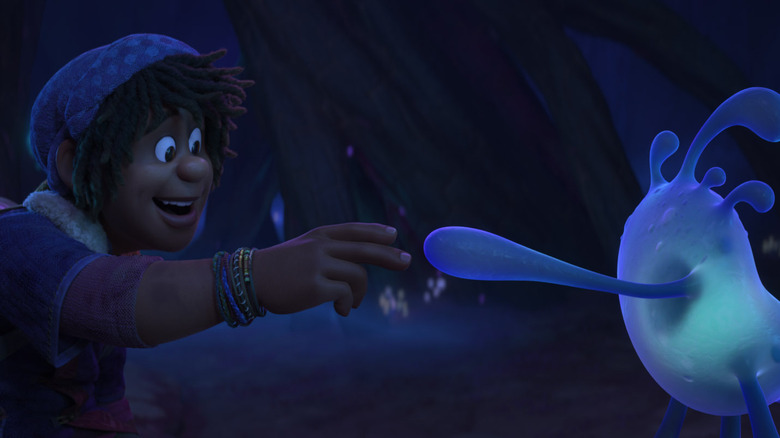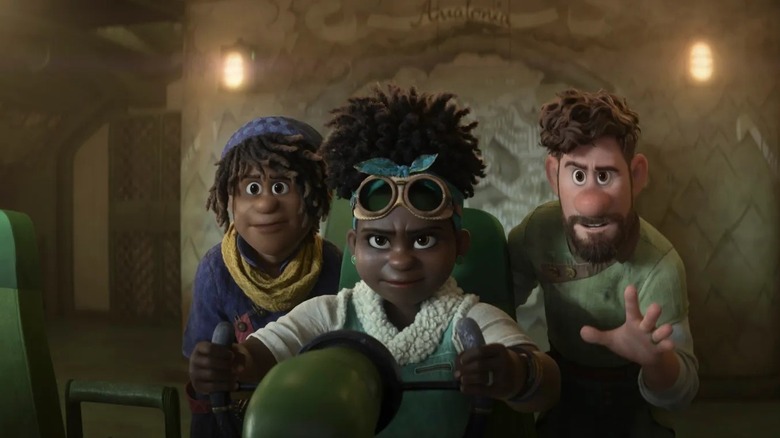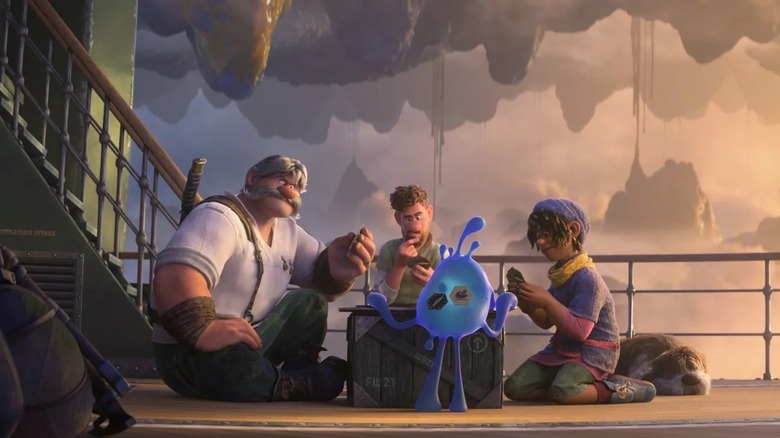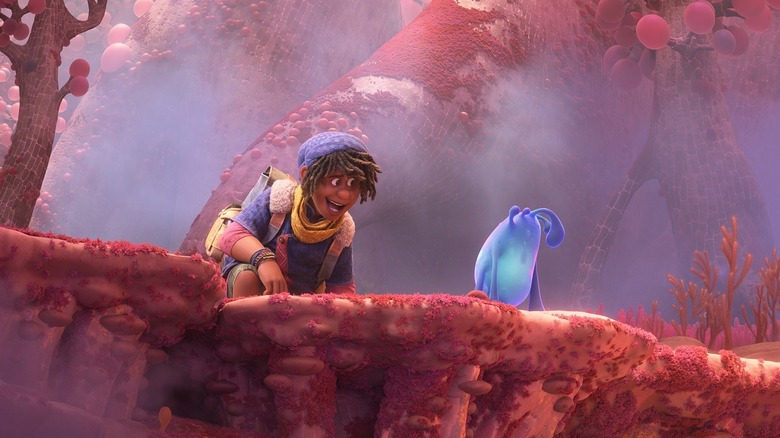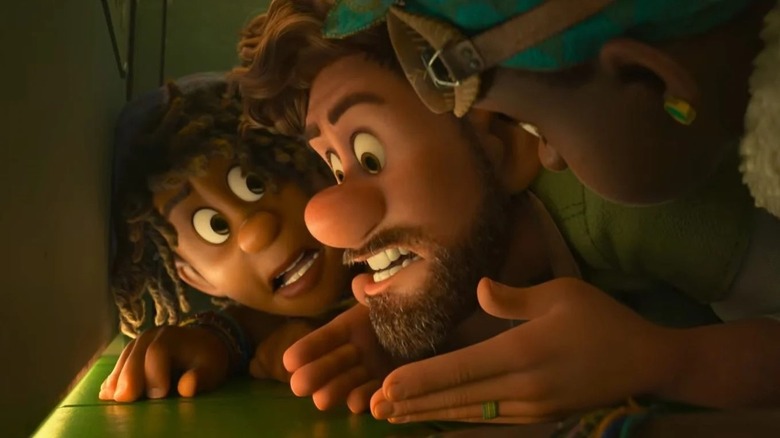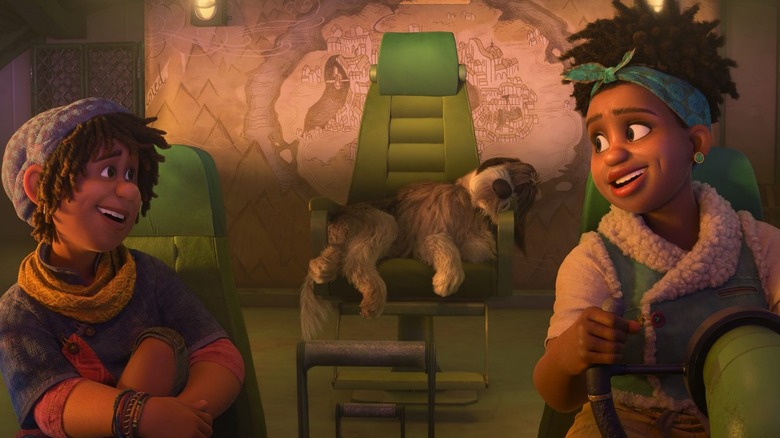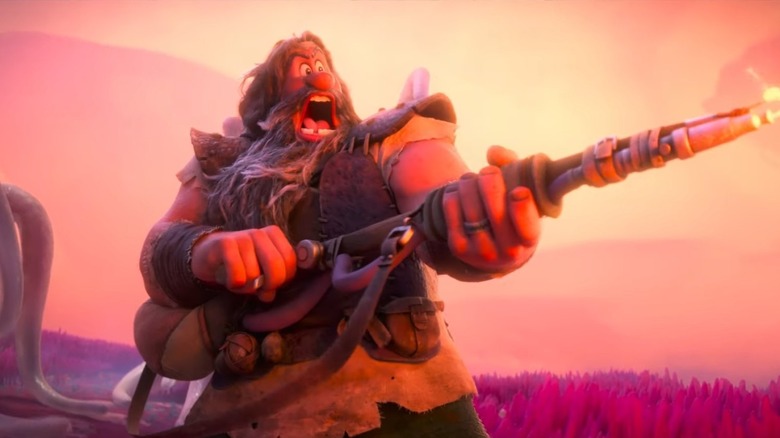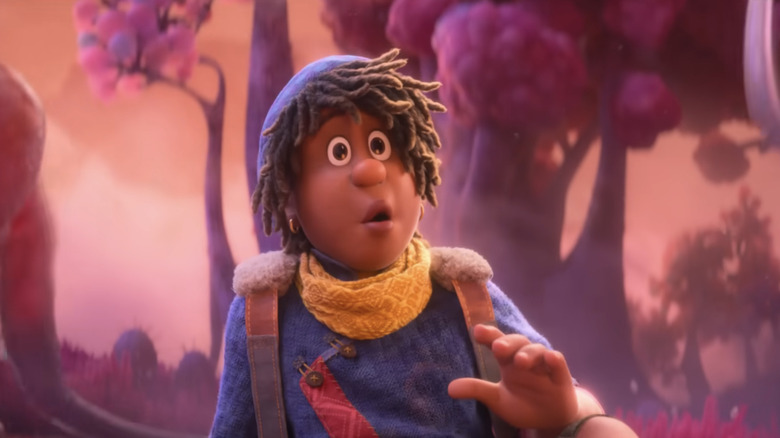6 Best And 6 Worst Things In Strange World
With "Strange World," Walt Disney Animation Studios returns to the world of science fiction action storytelling, a domain the studio has previously explored with productions like "Atlantis: The Lost Empire" and "Treasure Planet." This directorial effort from Don Hall (co-directed and written by Qui Nguyen) follows Searcher Clade (voiced by Jake Gyllenhaal) and his family, including wife Meridian (Gabrielle Union) and son Ethan (Jaboukie Young-White), traveling to a previously undiscovered world full of bizarre creatures and hazardous landscapes. It's a movie that's chock full of big action sequences and gorgeous visuals, not to mention the kind of emotional moments animated Disney projects have become famous for. Even if it's doubtful that "Strange World" will become the next "Encanto" or "Moana" for either kids or adults, it's also an enjoyable time that's especially fun to experience on a big screen.
Breaking down the best and worst elements of "Strange World" is a process that does, unfortunately, underscore why "Strange World" isn't quite equal to past Disney animated classics. On the other hand, this approach does highlight the various things "Strange World" does well, often very well in fact. No motion picture is perfect, especially one trying to juggle weighty themes and the marketing obligations of a Disney movie. The lows of "Strange World" reflect its inevitable imperfections, while its creative highs reflect why the film is an engaging experience more often than not.
This article contains spoilers for "Strange World."
Worst: Reliance on celebrity voice-overs
There's really no standout "terrible" voice-over performance by any of the cast of "Strange World," which is anchored by familiar names like Jake Gyllenhaal, Gabrielle Union, and Dennis Quaid. However, few of these performances are admittedly also good enough to help shake off the feeling that at least some of these characters could have been voiced by professional voice actors. The problem of stunt-casting recognizable live-action actors in American animated movies is not an issue exclusive to "Strange World." However, just because it's common in other movies like "Sing 2" or "The Bad Guys" doesn't absolve Disney from indulging in these casting choices.
The most awkward line deliveries from Gyllenhaal or Union immediately make one wish that longstanding legends in the voice acting field — like Tom Kenny, Cree Summer, or countless other figures — had gotten a chance to at least voice one or two members of the Clade family. Plus, since even the likes of Dennis Quaid would freely admit that they're not massive movie stars like Leonardo DiCaprio, it's doubtful hordes of people will show up to "Strange World" just because they're in it. Why not then buck the tradition of American animated movies and employ voice-over artists? "Strange World" features a lot of odd landscapes and critters, but its casting choices are to be expected for a mainstream Western animated film.
Best: The creature designs
"Strange World" certainly isn't short on eye candy, with every bizarre domain that the Clade family travels to being packed with bright colors and peculiar-looking critters. The latter beings are especially fun to look at since the animators and character designers have really committed to making these underground beasties look truly otherworldly. While their physical structure and behavior often mimic recognizable animals (like dinosaurs or birds), their designs are much more unusual. Most notably, none of these beasts have faces. There are no mouths or eyes to help the audience decipher what's going on inside the minds of these creatures.
Sometimes that ambiguity and restraint are used in the name of comedy, such as with the sidekick character Splat. In other instances, going this route with the creature designs makes these monsters genuinely imposing threats to the Clade family, ones whose next moves or interior worlds you can never make out. The nifty design choices even extend to beasts who only exist within the background. The inexplicable nature of other designs, such as a moving canyon shaped like an enormous pair of disembodied legs, makes the domain the Clades have found themselves in seem delightfully unpredictable. Thankfully, given its title, "Strange World" is never afraid to embrace oddball and confidently unique creature designs as part of its tantalizing visual scheme.
Worst: Struggles with comedy
The heart of "Strange World" lies in navigating complicated family dynamics and paying tribute to pieces of vintage science fiction media. Where its passions are less concentrated is in comedy. While "Strange World" is far from a wipeout in terms of laughs, some of the gags do feel like they're being shoehorned in just to fulfill a quota or a studio mandate for how funny a Disney animated title should be. They just don't feel as organic as other, more prominent parts of the production.
A handful of recurring gags involving a clumsy soldier voiced by Karan Soni, for instance, feels tacked on, while some of the physical comedy from comic sidekick Splat feels especially repetitive. There are only so many times you can watch this blob smack human beings before it loses its comedic edge. At least the film's least successful gags stumble quietly, rather than collapsing spectacularly or aggravatingly. Plus there are a handful of good jokes in here, with most of them coming from understated dialogue deliveries.
This film is another reminder that not all mainstream American animated movies need to fit into the same mold. Titles like "Strange World" shouldn't be forced to evoke the rampant comedy of "Despicable Me" just because that's generated massive box office in the past.
Best: The quiet dialogue-heavy scenes
A little over midway through "Strange World," after a deluge of big action sequences, it's time for the story to take a breather. Jaeger and Searcher pause for a moment to look out over their ship and share a drink. The two proceed to share a conversation, their first emotionally vulnerable exchange since the pair reunited. It's a sequence that's devoid entirely of fast-paced action, kid-friendly characters like Splat, or big pronounced instances of slapstick. It's just two human beings talking and beginning to grow closer.
This is the kind of sequence that other kids' movies might have cut entirely out of fear of boring adolescent viewers, like Disney did with the "When Love is Gone" musical number from "A Muppet Christmas Carol." Thankfully, such a scene is preserved in full for "Strange World" and the whole movie is better for it. Just this quick conversation fleshes out two of our lead characters nicely. This talk isn't just a boon in narrative terms though. This exchange also offers up a chance for the animators to execute some very well-realized bits of subtle physical acting. Any way you look at it, the willingness of the filmmakers to stop for these sorts of small moments is terrific.
Worst: Splat's noises
It may sound like a strange nitpick, but the decision to give Splat a bunch of squeaky noises is a strange choice that undercuts his ability to function as a silent comic sidekick. Disney is no stranger to such creations, thanks to Aladdin's magic carpet in "Aladdin," so there is precedent for making a character designed to create laughs while not chattering all the time.
While Splat doesn't speak English like the human leads of "Strange World," he may as well since he communicates in a series of unintelligible squeaks that approximate the English language. At least when other silent animated characters, like Toothless from "How to Train Your Dragon," make noises, it's to simulate the sort of grunts, whispers, and other sounds you hear from any animals. Splat, on the other hand, is always making high-pitched noises to convey important points to characters like Ethan, a form of communication that proves more irritating than endearing. Plus, going this route is counterintuitive to the concept of creating a character who doesn't speak traditional dialogue. The animators get some good visual gags out of Splat, but the character's speaking style needed to be adjusted or eliminated entirely.
Best: Strange World's visual aesthetic
In the book "The Art of Treasure Planet," the creators of that Disney animated movie explain that they came up with a rule for the feature's visual scheme. The 70/30 rule provided a guide for how the movie would mix distinctly futuristic science fiction elements with architecture, clothing, and other facets from the era in which "Treasure Island" was published. Whether it was a prop, set, or character design, "Treasure Planet" would draw 70% of its visual influence from one time period and 30% from another time period.
A similar approach seems to have gone into the visual aesthetic of "Strange World," and it turns out to be a good style to emulate. "Strange World" is populated by spaceships and tools that are rooted in the future. But there's also a retro quality to the layout of the homes — such as Searcher Clade's humble domicile — while the emphasis on how important old-school farming is also harkens back to earlier eras of American history. Meanwhile, the most prominent weapon in the film isn't a big ray gun, but a flamethrower. That device was created at the dawn of the 20th century, the era in which many of the sci-fi books "Strange World" is taking cues from also originated. Paying tribute to that era of history, not to mention — intentionally or not — channeling that same mix of the past with heightened sci-fi from "Treasure Planet," gives "Strange World" its delightful visual aesthetic.
Worst: The jam-packed script
It's not exactly common for American animated family movies to come under fire for being too stuffed with weighty ideas. This isn't a reflection on the capabilities of animation as a medium of storytelling, but rather how major American animated movies are often primarily concerned with how many Minions they can shove into a given frame. "Strange World" is an exception to this rule in that the screenplay by Qui Nguyen is packed to the gills with substantive ideas, most of them related to the concept of how people can start out as rebellious teenagers and grow up to be the very controlling parents they once despised.
It's a welcome and interesting backbone to hinge an entire story on, but Nguyen and director Don Hall's exploration of that idea is often a tad too expansive for its own good. Constantly switching between the perspectives of Searcher Clade and his son, Ethan, can be a bit jarring, especially since Ethan's openly welcoming attitude toward his dad makes it clear that Searcher's concerns about his son "abandoning" him like his own father are ill-founded. There's certainly value in exploring so much of the internal worlds of these respective characters. But "Strange World" did need to find a slightly more streamlined way to balance its protagonists, especially in a screenplay that's already got way more going on thematically than many other kid-friendly animated movies.
Best: Henry Jackman's score
Composer Henry Jackman is no stranger to the musical landscapes of Disney animated movies. Starting with the 2011 movie "Winnie the Pooh," Jackman has turned into a regular fixture of the studio's output and has overseen the music for movies ranging from "Wreck-It Ralph" to "Big Hero 6." This means that "Strange World" isn't totally unprecedented territory for the composer, though this homage to classic adventure stories is calling for a more old-fashioned auditory aesthetic than his other Disney animated films. It also calls for a lighter touch than many of his live-action features that are heavy on explosions and chase scenes, such as "The Gray Man" or "Extraction."
Jackman manages to come through as a composer on "Strange World" even with those challenges. His compositions don't just evoke classic adventure movies in their choice of instruments, but they also carry a spry, excitable quality that perfectly parallels a collection of characters exploring uncharted terrain. The willingness of "Strange World" to occasionally let dialogue have a rest and just let the images do all the talking also gives Jackman's score recurring chances to really shine. With his work on "Strange World," composer Henry Jackman can add another feather to his cap when it comes to Disney soundtracks.
Worst: The brief glimpse of hand-drawn animation
"Strange World" opens with a prologue explaining the legacy of the famed explorer Jaeger Clade, as well as the basic personality of his son, Searcher Clade. This opening is told in an old-fashioned style of hand-drawn animation meant to emulate classic comics, right down to the characters being covered in Ben-Day dots. The presence of hand-drawn animation in this sequence is a drawback for "Strange World," but only because of how good it is. The renderings of Jaeger and Searcher are incredibly smooth, their character designs look great when applied to the world of 2D animation, and the various extravagant locales they travel through pop right off the screen when realized in this animation style.
Unfortunately, this is not the default animation style of the rest of "Strange World." Once the movie shifts into computer animation, the whole thing looks pretty, but much more generic, with character designs and movements that could have come from any Disney animated title from "Tangled" onward. What a pity that a feature intended to emulate classic adventure yarns couldn't have been executed with a similarly old-school animation style. The luscious hand-drawn animation prologue and its assortment of very distinctive visual touches suggest a much more expressive and unique way that the story of "Strange World" could have been told.
Best: Strange World's empathy for younger characters
It's easy for mainstream movies to have a dismissive attitude toward teenagers. Even among recent Disney features, "Disenchanted" showcased the default norm for big-screen teenagers by reducing teenager Morgan (Gabriella Baldacchino) to a sullen soul who can't stay off her phone. No matter what era it is, teenagers and other younger characters are often an easy target for movies, especially since mocking their rebellious ways can "comfortingly" reinforce the status quo to older viewers. Thankfully, the screenplay of "Strange World" is much more empathetic towards Ethan, whose ambitions, interests, and personality are given a considerable amount of empathy.
The film's climax even encourages youngsters in the audience to stick to their guns about their own wishes and that it's okay to not always listen to your parents. The final scene focuses entirely on Ethan charting out his own life, separate from his parents' expectations, while throughout the rest of the movie the concept that Ethan isn't old enough to know his own wishes is portrayed as ridiculous. This heartfelt approach to the teenaged Ethan is a byproduct of the empathetic spirit of "Strange World," which extends to older characters like Ethan's father and grandfather. But contrary to most mainstream movies, "Strange World" doesn't just turn its teenage character into a punching bag or hokey caricature.
Worst: The surprise villain
The finale of "Strange World" begins with Searcher and Ethan racing back to their allies to let them know that they can't destroy the creatures that are damaging the energy supply of their home, the land of Avalonia. This underground world needs to be protected, not harmed for the gain of surface-dwellers. This is when Callisto Mal (Lucy Liu), the ruler of Avalonia, suddenly announces that she's taking over the mission. This previously helpful character is now the antagonist of "Strange World," ordering her soldiers to continue harming the critters and their environment so that her homeland can be saved. If this means the Clade family has to be locked in a broom closet until this mission's complete, so be it.
The moment this heel turn begins, one can't help but already groan. A character like Mal becoming a baddie isn't that much of a surprise, since modern Disney movies have gone to the "secret villain" well a lot. This is an especially weak example of that trend, however, as Mal isn't even evil long enough to have an impact on the plot. Splat gets the family out of the broom closet quite quickly, while Mal is similarly very speedy in seeing the error of her ways and returning to the side of the good guys. Her sudden detour into villainy just feels like "Strange World" is tossing more conflict into a story that's already got plenty of drama to go around.
Best: The LGBTQIA+ representation
After years of delivering solely background characters who were queer or only passing acknowledgment of the LGBTQIA+ community (via Them), "Strange World" is the first Disney Animation Studios feature to contain an out queer lead character in the form of Ethan (Jaboukie Young-White). An event that's been a long time coming is, happily, played as no big deal within the context of "Strange World." Ethan's crush on another teenage boy is played as a classic example of somebody's first love, with one of the movie's most amusing scenes involving Searcher playing the traditional role of a dad embarrassing his teenage child around their crush.
Even better, the sudden introduction of the much older Jaeger doesn't send "Strange World" onto a narrative detour of Ethan having to justify his sexuality to his grandpa. Instead, Jaeger asking Ethan if he's got "any sweethearts" back home leads to Ethan casually talking about a guy that he likes but can't seem to talk to. There's never any questioning from Jaeger or anyone else in the cast of "Strange World" about this aspect of Ethan's character, nor is his queerness the sole defining trait of this teenage hero. It's just another part of the tapestry of "Strange World," a wonderful aspect that, hopefully, paves the way for further and constant queer representation in future Disney Animation Studios releases.
